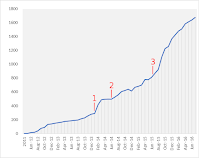We frequently marvel at how sketchy the advice was in Original D&D (and other early editions) was for the number of monsters, amount of treasure, and expected rate of PC advancement in the dungeons.
There are a few semi-secondary sources that give estimates for advancement rates -- and it's rather remarkable how widely they differ. This is even though they all date from a time post-OD&D-Supplement-I, so they're all using basically the same monster XP chart and treasure tables.
Gygax in The Strategic Review Vol. 2, #2, p. 23 (1976)
It is reasonable to calculate that if a fair player takes part in 50 to 75 games in the course of a year he should acquire sufficient experience points to make him about 9th to 11th level, assuming that he manages to survive all that play. The acquisition of successively higher levels will be proportionate to enhanced power and the number of experience points necessary to attain them, so another year of play will by no means mean a doubling of levels but rather the addition of perhaps two or three levels. Using this gauge, it should take four or five years to see 20th level. As BLACKMOOR is the only campaign with a life of five years, and GREYHAWK with a life of four is the second longest running campaign, the most able adventurers should not yet have attained 20th level except in the two named campaigns. To my certain knowledge no player in either BLACKMOOR or GREYHAWK has risen above 14th level.
Note that on average this suggests about 60 games in the first year of play to achieve 10th level (i.e., an average of 6 games/level; but there's no reason to think this is a uniform rate over the ten levels). The data points afterward suggest a subsequent rate of about 2.5 levels gained per year of play. Obviously: that's an enormous number of games by modern standards!
Holmes in Basic D&D, p. 22 (1977)
As a guideline, it should take a group of players from 6 to 12 adventures before any of their characters are able to gain sufficient experience to attain second level. This guidelining will hold true for successive levels. Note that it is assumed that the 6 to 12 adventures are ones in which a fair amount of treasure was brought back — some 10% to 20% of adventures will likely prove relatively profitless for one reason or another.
On average, this works out to 9 adventures per level -- 50% slower than Gygax's general estimate (prior to name level).
Moldvay in B/X, p. B61 (1981)
If no one has reached the 2nd level of experience in three or four adventures, the DM should consider giving more treasure. If most of the players have reached the 3rd level of experience in this time, the DM should consider cutting down the amount of treasure, or increasing the "toughness" of the monsters.
On average, this suggests around 2.5 adventures to gain the first level-up -- over 50% faster than Gygax's general estimate.
Is it surprising how much those estimates vary? The one thing I might point to as a difference is that Gygax's play in OD&D/AD&D awards (some) XP for acquisition of magic items, whereas that's never suggested in the Basic D&D lines. Hypothetically that might explain why the Holmes rate is slower, but certainly not why the Moldvay rate is faster.
Can you think of any other obvious mechanical differences in those rules that would explain that? Which rate best matches your experience at the table? Which best matches your desire as a DM at the table?
